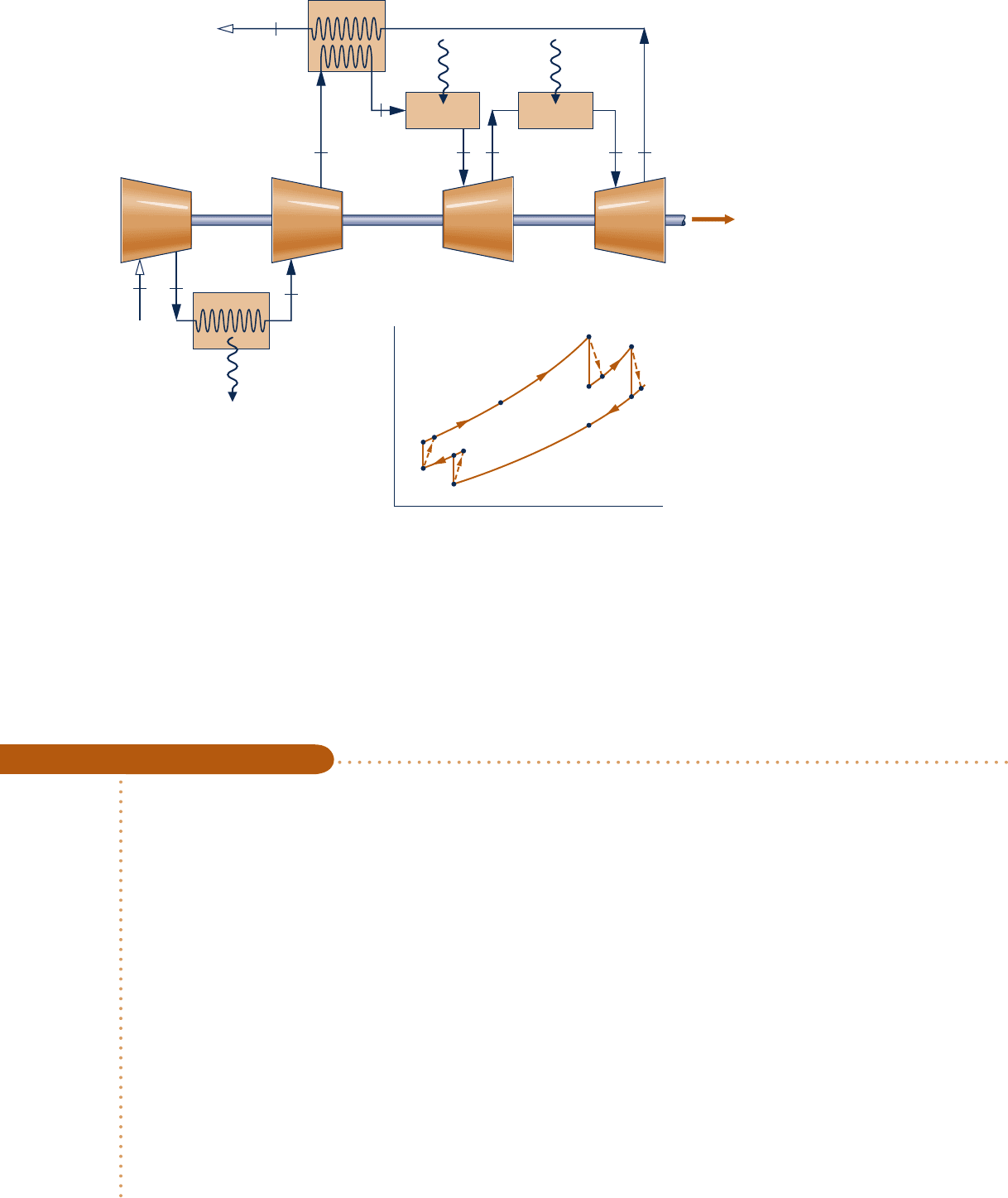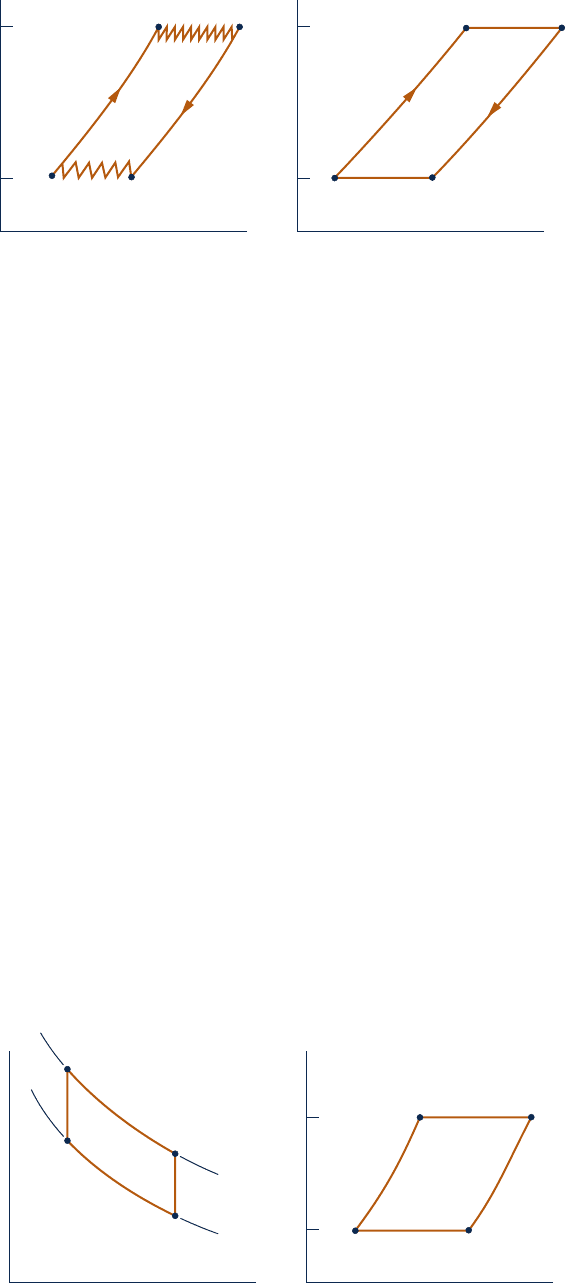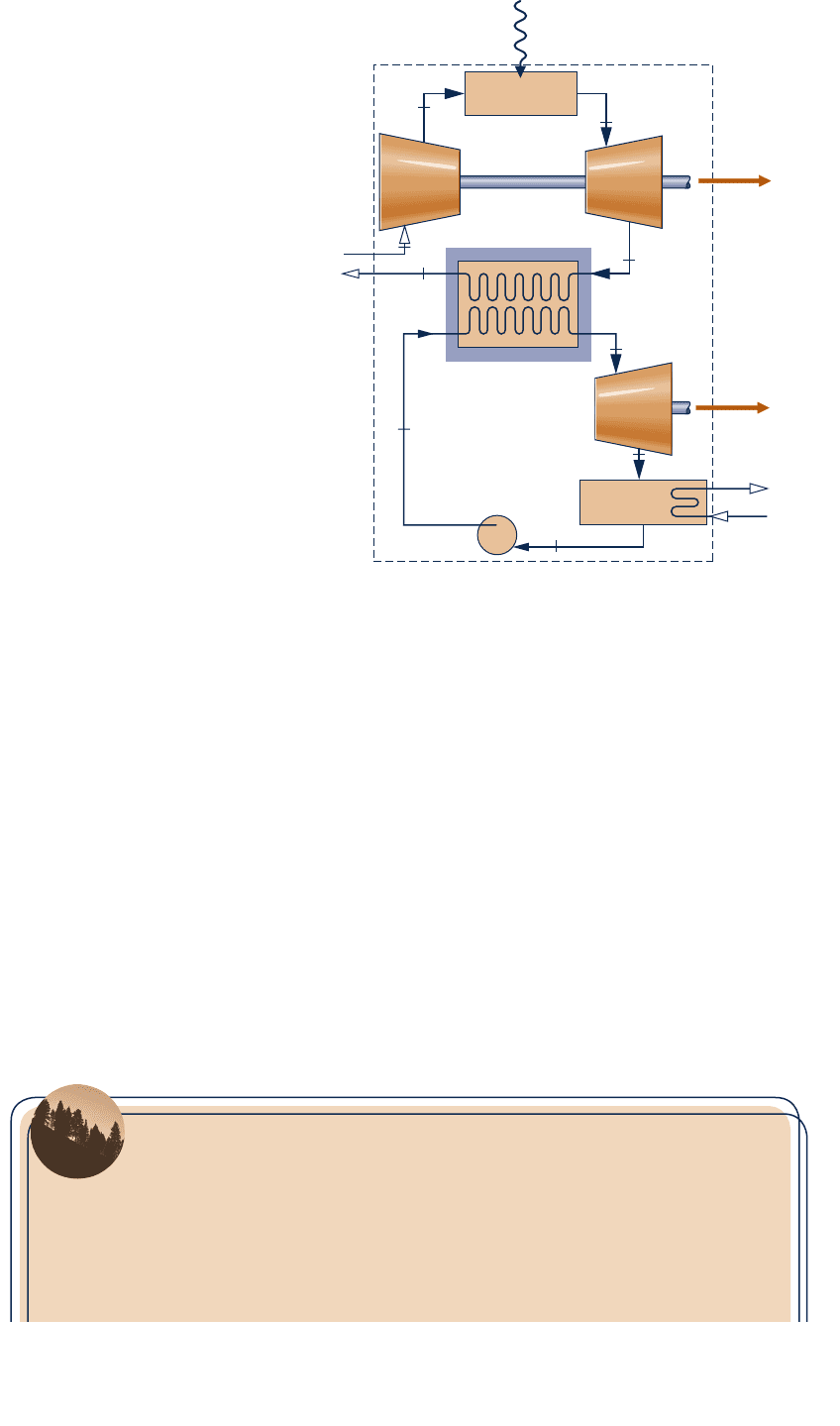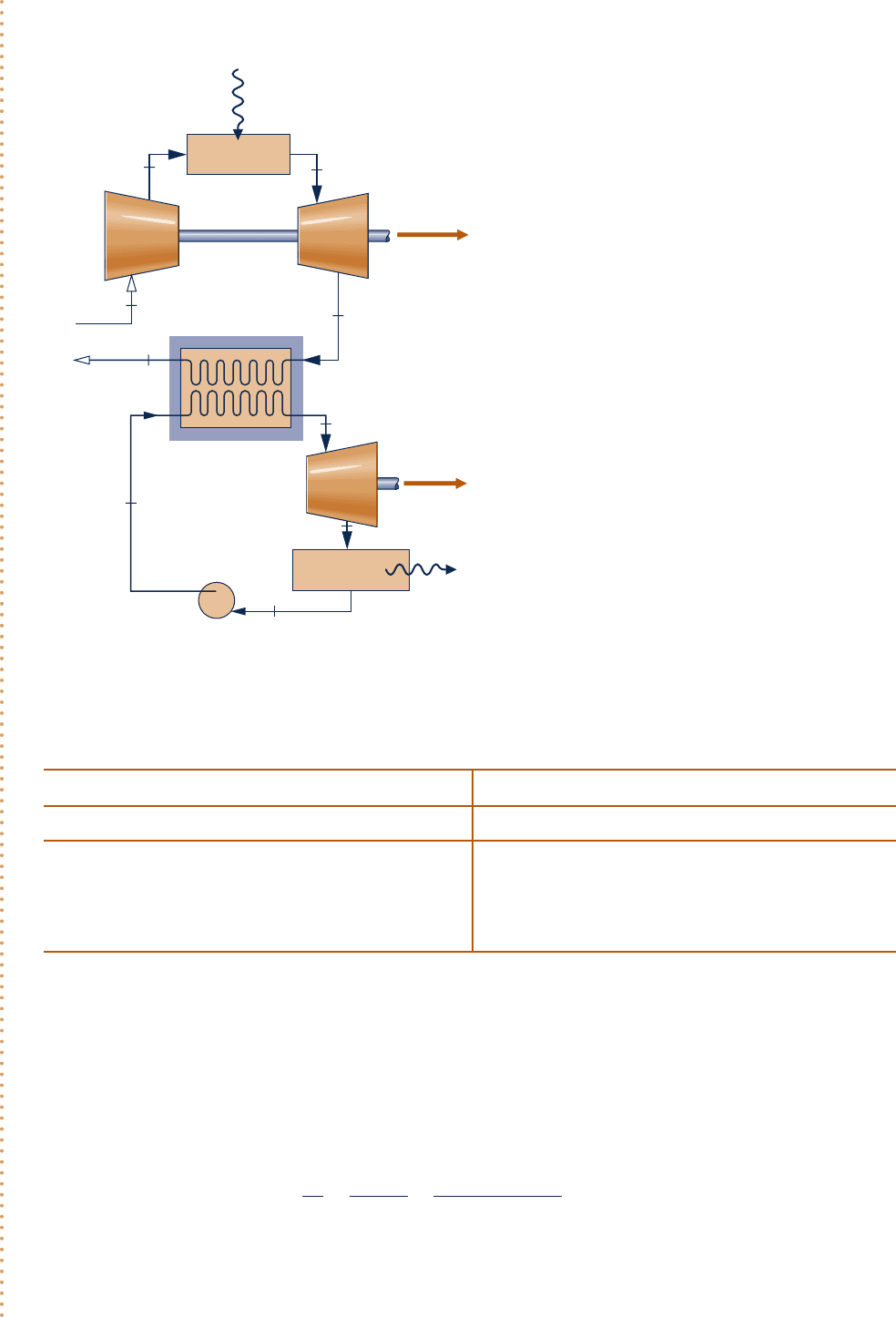Moran M.J., Shapiro H.N. Fundamentals of Engineering Thermodynamics
Подождите немного. Документ загружается.


and turbine stages. The pressure drops that would occur as the working fluid passes
through the intercooler, regenerator, and combustors are not shown.
Example 9.11 illustrates the analysis of a regenerative gas turbine with intercooling
and reheat.
Analyzing a Regenerative Gas Turbine with Intercooling and Reheat
c c c c EXAMPLE 9.11 c
A regenerative gas turbine with intercooling and reheat operates at steady state. Air enters the compressor at
100 kPa, 300 K with a mass flow rate of 5.807 kg/s. The pressure ratio across the two-stage compressor is 10. The
pressure ratio across the two-stage turbine is also 10. The intercooler and reheater each operate at 300 kPa. At
the inlets to the turbine stages, the temperature is 1400 K. The temperature at the inlet to the second compres-
sor stage is 300 K. The isentropic efficiency of each compressor and turbine stage is 80%. The regenerator
effectiveness is 80%. Determine (a) the thermal efficiency, (b) the back work ratio, (c) the net power developed,
in kW.
SOLUTION
Known:
An air-standard regenerative gas turbine with intercooling and reheat operates at steady state. Operating
pressures and temperatures are specified. Turbine and compressor isentropic efficiencies are given and the regen-
erator effectiveness is known.
Find: Determine the thermal efficiency, back work ratio, and net power developed, in kW.
9.8 Regenerative Gas Turbines with Reheat and Intercooling 533
Fig. 9.19
Regenerative gas turbine with intercooling and reheat.
2
3
Compressor
1
Compressor
2
W
·
cycle
1
Intercooler
Q
·
out
Turbine
2
Turbine
1
Combustor 1
5
467 9
10
Regenerator
Q
·
in,
1
Combustor 2
8
Q
·
in,
2
T
s
1
3
4
5
6
8
9s
7s
10
9
7
4s
2s
2
c09GasPowerSystems.indd Page 533 7/19/10 9:50:54 AM users-133 c09GasPowerSystems.indd Page 533 7/19/10 9:50:54 AM users-133 /Users/users-133/Desktop/Ramakant_04.05.09/WB00113_R1:JWCL170/New/Users/users-133/Desktop/Ramakant_04.05.09/WB00113_R1:JWCL170/New

534 Chapter 9 Gas Power Systems
Schematic and Given Data:
Analysis:
We begin by listing the specific enthalpies at the principal states of this cycle. The enthalpies at states
1, 2s, 3, and 4s are obtained from the solution to Example 9.9 where these states are designated as 1, c, d, and
2, respectively. Thus, h
1
5 h
3
5 300.19 kJ/kg, h
2s
5 411.3 kJ/kg, h
4s
5 423.8 kJ/kg.
The specific enthalpies at states 6, 7s, 8, and 9s are obtained from the solution to Example 9.8, where these states
are designated as 3, a, b, and 4, respectively. Thus, h
6
5 h
8
5 1515.4 kJ/kg, h
7s
5 1095.9 kJ/kg, h
9s
5 1127.6 kJ/kg.
The specific enthalpy at state 4 can be determined using the isentropic efficiency of the second compressor
stage
h
c
5
h
4s
2 h
3
h
4
2 h
3
Solving for h
4
h
4
5 h
3
1
h
4s
2 h
3
h
c
5 300.19 1 a
423.8 2 300.19
0.8
b
5 454.7 kJ
/
kg
Similarly, the specific enthalpy at state 2 is h
2
5 439.1 kJ/kg.
The specific enthalpy at state 9 can be determined using the isentropic efficiency of the second turbine stage
h
t
5
h
8
2 h
9
h
8
2 h
9s
Solving for h
9
h
9
5 h
8
2 h
t
1h
8
2 h
9s
25 1515.4 2 0.811515.4 2 1127.62
5 1205.2 kJ
/
kg
Similarly, the specific enthalpy at state 7 is h
7
5 1179.8 kJ/kg.
Engineering Model:
1.
Each component
is analyzed as a
control volume at
steady state. The
control volumes
are shown on the
accompanying
sketch by dashed
lines.
2. There are no pres-
sure drops for flow
through the heat
exchangers.
3. The compressor
and turbine are
adiabatic.
4. Kinetic and poten-
tial energy effects
are negligible.
5. The working fluid
is air modeled as
an ideal gas.
Fig. E9.11
2
3
Compressor
1
Compressor
2
W
·
cycle
1
Intercooler
Q
·
out
Turbine
2
Turbine
1
Combustor
5
467 9
10
Regenerator
Q
·
in,
1
Reheat
combustor
8
Q
·
in,
2
T
s
1
3
4
5
6
8
9s
7s
10
9
7
4s
2s
2
T
1
= 300 K
p
1
= 100 kPa
m
·
= 5.807 kg/s
p
2
= p
3
= 300 kPa
p
4
= p
5
= p
6
=
1000 kPa
T
6
= T
8
= 1400 K p
7
= p
8
= 300 kPa
c09GasPowerSystems.indd Page 534 7/19/10 9:50:56 AM users-133 c09GasPowerSystems.indd Page 534 7/19/10 9:50:56 AM users-133 /Users/users-133/Desktop/Ramakant_04.05.09/WB00113_R1:JWCL170/New/Users/users-133/Desktop/Ramakant_04.05.09/WB00113_R1:JWCL170/New

9.8.4
Ericsson and Stirling Cycles
As illustrated by Example 9.11, significant increases in the thermal efficiency of gas
turbine power plants can be achieved through intercooling, reheat, and regeneration.
There is an economic limit to the number of stages that can be employed, and nor-
mally there would be no more than two or three. Nonetheless, it is instructive to
consider the situation where the number of stages of both intercooling and reheat
becomes indefinitely large.
9.8 Regenerative Gas Turbines with Reheat and Intercooling 535
The specific enthalpy at state 5 can be determined using the regenerator effectiveness
h
reg
5
h
5
2 h
4
h
9
2 h
4
Solving for h
5
h
5
5 h
4
1 h
reg
1h
9
2 h
4
25 454.7 1 0.811205.2 2 454.72
5 1055.1 kJ
/
kg
(a) The thermal efficiency must take into account the work of both turbine stages, the work of both compressor
stages, and the total heat added. The total turbine work per unit of mass flow is
W
#
t
m
#
5 1h
6
2 h
7
21 1h
8
2 h
9
2
5 11515.4 2 1179.821 11515.4 2 1205.225 645.8 kJ
/
kg
The total compressor work input per unit of mass flow is
W
#
c
m
#
5 1h
2
2 h
1
21 1h
4
2 h
3
2
5 1439.1 2 300.1921 1454.7 2 300.1925 293.4 kJ
/
kg
The total heat added per unit of mass flow is
Q
#
in
m
#
5 1h
6
2 h
5
21 1h
8
2 h
7
2
5 11515.4 2 1055.121 11515.4 2 1179.825 795.9 kJ
/
kg
Calculating the thermal efficiency
h 5
645.8 2 293.4
795.9
5 0.443 144.3%2
(b) The back work ratio is
bwr 5
W
#
c
/
m
#
W
#
t
/
m
#
5
293.
4
645.8
5 0.454 145.4%2
(c) The net power developed is
W
#
cycle
5 m
#
1W
#
t
/
m
#
2 W
#
c
/
m
#
2
5 a5.807
k
g
s
b1645.8 2 293.42
k
J
kg
`
1 kW
1 kJ
/
s
`5 2046 kW
➊ Comparing the thermal efficiency, back work ratio, and net power values of
the current example with the corresponding values of Example 9.6, it should
be evident that gas turbine power plant performance can be increased sig-
nificantly by coupling reheat and intercooling with regeneration.
Using the results of parts (a) and (c), determine the total rate
of heat addition to the cycle, in kW. Ans. 4619 kW.
Ability to…
❑
sketch the schematic of the
regenerative gas turbine
with intercooling and reheat
and the T–s diagram for the
corresponding air-standard
cycle.
❑
evaluate temperatures and
pressures at each principal
state and retrieve necessary
property data.
❑
calculate the thermal effi-
ciency, back work ratio, and
net power developed.
✓
Skills Developed
➊
c09GasPowerSystems.indd Page 535 7/19/10 9:50:59 AM users-133 c09GasPowerSystems.indd Page 535 7/19/10 9:50:59 AM users-133 /Users/users-133/Desktop/Ramakant_04.05.09/WB00113_R1:JWCL170/New/Users/users-133/Desktop/Ramakant_04.05.09/WB00113_R1:JWCL170/New

536 Chapter 9
Gas Power Systems
ERICSSON CYCLE. Figure 9.20a shows an ideal regenerative gas turbine cycle
with several stages of compression and expansion and a regenerator whose effective-
ness is 100%. As in Fig. 9.8b, this is a closed gas turbine cycle. Each intercooler is
assumed to return the working fluid to the temperature T
C
at the inlet to the first
compression stage and each reheater restores the working fluid to the temperature
T
H
at the inlet to the first turbine stage. The regenerator allows the heat input for
Process 2–3 to be obtained from the heat rejected in Process 4–1. Accordingly, all the
heat added externally occurs in the reheaters, and all the heat rejected to the sur-
roundings takes place in the intercoolers.
In the limit, as an infinite number of reheat and intercooler stages are employed,
all heat added occurs when the working fluid is at its highest temperature, T
H
, and
all heat rejected takes place when the working fluid is at its lowest temperature, T
C
.
The limiting cycle, shown in Fig. 9.20b, is called the Ericsson cycle.
Since irreversibilities are presumed absent and all heat is supplied and rejected
isothermally, the thermal efficiency of the Ericsson cycle equals that of any reversible
power cycle operating with heat addition at the temperature T
H
and heat rejection at
the temperature T
C
: h
max
5 1 2 T
C
/T
H
. This expression is applied in Secs. 5.10 and
6.6 to evaluate the thermal efficiency of Carnot power cycles. Although the details of
the Ericsson cycle differ from those of the Carnot cycle, both cycles have the same
value of thermal efficiency when operating between the temperatures T
H
and T
C
.
STIRLING CYCLE. Another cycle that employs a regenerator is the Stirling cycle,
shown on the p–y and T–s diagrams of Fig. 9.21. The cycle consists of four internally
reversible processes in series: isothermal compression from state 1 to state 2 at tem-
perature T
C
, constant-volume heating from state 2 to state 3, isothermal expansion
Ericsson cycle
Fig. 9.20 Ericsson cycle as a limit of ideal gas turbine operation using multistage compression
with intercooling, multistage expansion with reheating, and regeneration.
21
34
T
H
p = c
(a)(b)
p = c
T
C
T
s
2
1
3
4
T
H
p = c
p = c
T
C
T
s
Fig. 9.21 p–y and T–s diagrams of the Stirling cycle.
2
3
1
4
T
H
T = c
T = c
T
C
p
v
2
1
3
4
T
H
v = c
v = c
T
C
T
s
c09GasPowerSystems.indd Page 536 7/19/10 9:51:01 AM users-133 c09GasPowerSystems.indd Page 536 7/19/10 9:51:01 AM users-133 /Users/users-133/Desktop/Ramakant_04.05.09/WB00113_R1:JWCL170/New/Users/users-133/Desktop/Ramakant_04.05.09/WB00113_R1:JWCL170/New

from state 3 to state 4 at temperature T
H
, and constant-volume cooling from state 4
to state 1 to complete the cycle.
A regenerator whose effectiveness is 100% allows the heat rejected during Process
4–1 to provide the heat input in Process 2–3. Accordingly, all the heat added to the
working fluid externally takes place in the isothermal process 3–4 and all the heat
rejected to the surroundings occurs in the isothermal process 1–2.
It can be concluded, therefore, that the thermal efficiency of the Stirling cycle is
given by the same expression as for the Carnot and Ericsson cycles. Since all three
cycles are reversible, we can imagine them as being executed in various ways, includ-
ing use of gas turbines and piston–cylinder engines. In each embodiment, however,
practical issues prevent it from actually being realized.
STIRLING ENGINE. The Ericsson and Stirling cycles are principally of theoreti-
cal interest as examples of cycles that exhibit the same thermal efficiency as the
Carnot cycle. However, a practical engine of the piston–cylinder type that operates
on a closed regenerative cycle having features in common with the Stirling cycle has
been under study for years. This engine is known as a Stirling engine. The Stirling
engine offers the opportunity for high efficiency together with reduced emissions
from combustion products because combustion takes place externally and not within
the cylinder as for internal combustion engines. In the Stirling engine, energy is trans-
ferred to the working fluid from products of combustion, which are kept separate. It
is an external combustion engine.
Stirling engine
9.9 Gas Turbine–Based Combined Cycles
In this section, gas turbine–based combined cycles are considered for power genera-
tion. Cogeneration, including district heating, is also considered. These discussions
complement those of Sec. 8.5, where vapor power system performing similar functions
are introduced.
The present applications build on recognizing that the exhaust gas temperature of
a simple gas turbine is typically well above ambient temperature and thus hot gas
exiting the turbine has significant thermodynamic utility that might be harnessed
economically. This observation provides the basis for the regenerative gas turbine
cycle introduced in Sec. 9.7 and for the current applications.
9.9.1
Combined Gas Turbine–Vapor Power Cycle
A combined cycle couples two power cycles such that the energy discharged by heat
transfer from one cycle is used partly or wholly as the heat input for the other cycle.
This is illustrated by the combined cycle involving gas and vapor power turbines shown
in Fig. 9.22. The gas and vapor power cycles are combined using an interconnecting
heat-recovery steam generator that serves as the boiler for the vapor power cycle.
The combined cycle has the gas turbine’s high average temperature of heat addi-
tion and the vapor cycle’s low average temperature of heat rejection, and thus a
thermal efficiency greater than either cycle would have individually. For many appli-
cations combined cycles are a good choice, and they are increasingly being used
worldwide for electric power generation.
With reference to Fig. 9.22, the thermal efficiency of the combined cycle is
h 5
W
#
gas
1 W
#
vap
Q
#
in
(9.28)
where W
#
gas
is the net power developed by the gas turbine and W
#
vap
is the net power
developed by the vapor cycle. Q
#
in
denotes the total rate of heat transfer to the com-
bined cycle, including additional heat transfer, if any, to superheat the vapor entering
9.9 Gas Turbine–Based Combined Cycles 537
c09GasPowerSystems.indd Page 537 7/19/10 9:51:06 AM users-133 c09GasPowerSystems.indd Page 537 7/19/10 9:51:06 AM users-133 /Users/users-133/Desktop/Ramakant_04.05.09/WB00113_R1:JWCL170/New/Users/users-133/Desktop/Ramakant_04.05.09/WB00113_R1:JWCL170/New

538 Chapter 9 Gas Power Systems
the vapor turbine. The evaluation of the quantities appearing in Eq. 9.28 follows the
procedures described in the sections on vapor cycles and gas turbines.
The relation for the energy transferred from the gas cycle to the vapor cycle for
the system of Fig. 9.22 is obtained by applying the mass and energy rate balances to
a control volume enclosing the heat-recovery steam generator. For steady-state oper-
ation, negligible heat transfer with the surroundings, and no significant changes in
kinetic and potential energy, the result is
m
#
v
1h
7
2 h
6
25 m
#
g
1h
4
2 h
5
2 (9.29)
where m
#
g
and m
#
v
are the mass flow rates of the gas and vapor, respectively.
As witnessed by relations such as Eqs. 9.28 and 9.29, combined cycle performance
can be analyzed using mass and energy balances. To complete the analysis, however,
the second law is required to assess the impact of irreversibilities and the true mag-
nitudes of losses. Among the irreversibilities, the most significant is the exergy
destroyed by combustion. About 30% of the exergy entering the combustor with the
fuel is destroyed by combustion irreversibility. An analysis of the gas turbine on an
air-standard basis does not allow this exergy destruction to be evaluated, however,
and means introduced in Chap. 13 must be applied for this purpose.
ENERGY & ENVIRONMENT Advanced combined-cycle H-class power plants
capable of achieving the long-elusive 60% combined-cycle thermal efficiency level are
a reality. Here H denotes the largest electric power gas turbines. H-class power plants
integrate a gas turbine, steam turbine, steam generator, and heat-recovery steam generator. They
are capable of net power outputs reaching nearly 600 MW, while significantly saving fuel, reducing
carbon dioxide emissions, and adhering to low nitric oxides standards.
Before the H-class breakthrough, gas turbine manufacturers had struggled against a temperature-
imposed barrier that limited thermal efficiency for gas turbine-based power systems. For years, the
Fig. 9.22 Combined gas
turbine–vapor power plant.
Combustor
TurbineCompressor
Q
·
in
W
·
gas
W
·
vap
Cooling
water
Vapor
cycle
Heat-recovery
steam generator
Condenser
Gas turbine
Air inlet
Exhaust
Pump
2
3
4
1
5
6
9
Turbine
7
8
c09GasPowerSystems.indd Page 538 7/19/10 9:51:06 AM users-133 c09GasPowerSystems.indd Page 538 7/19/10 9:51:06 AM users-133 /Users/users-133/Desktop/Ramakant_04.05.09/WB00113_R1:JWCL170/New/Users/users-133/Desktop/Ramakant_04.05.09/WB00113_R1:JWCL170/New

The next example illustrates the use of mass and energy balances, the second law,
and property data to analyze combined cycle performance.
barrier was a gas turbine inlet temperature of about 12608C (23008F). Above that level, available
cooling technologies were unable to protect turbine blades and other key components from ther-
mal degradation. Since higher temperatures go hand-in-hand with higher thermal efficiencies, the
perceived temperature barrier limited the efficiency achievable.
Two developments were instrumental in allowing combined-cycle thermal efficiencies of 60%
or more: steam cooling of both stationary and rotating blades and blades made from single
crystals.
c In steam cooling, relatively low-temperature steam generated in the companion vapor power
plant is fed to channels in the blades of the high-temperature stages of the gas turbine, thereby
cooling the blades while producing superheated steam for use in the vapor plant, adding to
overall cycle efficiency. Innovative coatings, typically ceramic composites, also help compo-
nents withstand very high gas temperatures.
c H-class gas turbines also have single-crystal blades. Conventionally cast blades are polycrystal-
line. They consist of a multitude of small grains (crystals) with interfaces between the grains
called grain boundaries. Adverse physical events such as corrosion and creep originating at
grain boundaries greatly shorten blade life and impose limits on allowed turbine temperatures.
Having no grain boundaries, single-crystal blades are far more durable and less prone to ther-
mal degradation.
Energy and Exergy Analyses of a Combined Gas Turbine-Vapor Power Plant
c c c c EXAMPLE 9.12 c
A combined gas turbine–vapor power plant has a net power output of 45 MW. Air enters the compressor of
the gas turbine at 100 kPa, 300 K, and is compressed to 1200 kPa. The isentropic efficiency of the compres-
sor is 84%. The condition at the inlet to the turbine is 1200 kPa, 1400 K. Air expands through the turbine,
which has an isentropic efficiency of 88%, to a pressure of 100 kPa. The air then passes through the intercon-
necting heat-recovery steam generator and is finally discharged at 400 K. Steam enters the turbine of the
vapor power cycle at 8 MPa, 4008C, and expands to the condenser pressure of 8 kPa. Water enters the pump
as saturated liquid at 8 kPa. The turbine and pump of the vapor cycle have isentropic efficiencies of 90 and
80%, respectively.
(a) Determine the mass flow rates of the air and the steam, each in kg/s; the net power developed by the gas
turbine and vapor power cycle, each in MW; and the thermal efficiency.
(b) Develop a full accounting of the net rate of exergy increase as the air passes through the gas turbine com-
bustor. Discuss.
Let T
0
5 300 K, p
0
5 100 kPa.
SOLUTION
Known:
A combined gas turbine–vapor power plant operates at steady state with a known net power output.
Operating pressures and temperatures are specified. Turbine, compressor, and pump efficiencies are also given.
Find: Determine the mass flow rate of each working fluid, in kg/s; the net power developed by each cycle, in
MW; and the thermal efficiency. Develop a full accounting of the exergy increase of the air passing through the
gas turbine combustor and discuss the results.
9.9 Gas Turbine–Based Combined Cycles 539
c09GasPowerSystems.indd Page 539 7/19/10 9:51:09 AM users-133 c09GasPowerSystems.indd Page 539 7/19/10 9:51:09 AM users-133 /Users/users-133/Desktop/Ramakant_04.05.09/WB00113_R1:JWCL170/New/Users/users-133/Desktop/Ramakant_04.05.09/WB00113_R1:JWCL170/New

540 Chapter 9 Gas Power Systems
Schematic and Given Data:
Analysis: The property data given in the table below are determined using procedures illustrated in previous
solved examples of Chaps. 8 and 9. The details are left as an exercise.
Gas Turbine Vapor Cycle
State h (kJ/kg) s8 (kJ/kg ? K) State h (kJ/kg) s (kJ/kg ? K)
1 300.19 1.7020 6 183.96 0.5975
2 669.79 2.5088 7 3138.30 6.3634
3 1515.42 3.3620 8 2104.74 6.7282
4 858.02 2.7620 9 173.88 0.5926
5 400.98 1.9919
Energy Analysis
(a)
To determine the mass flow rates of the vapor, m
#
v
, and the air, m
#
g
, begin by applying mass and energy rate
balances to the interconnecting heat-recovery steam generator to obtain
0 5 m
#
g
1h
4
2 h
5
21 m
#
v
1h
6
2 h
7
2
or
m
#
v
m
#
g
5
h
4
2 h
5
h
7
2 h
6
5
858.02 2 400.98
3138.3 2 183.96
5 0.1547
Engineering Model:
1.
Each component on the accompanying sketch
is analyzed as a control volume at steady state.
2. The turbines, compressor, pump, and inter-
connecting heat-recovery steam generator
operate adiabatically.
3. Kinetic and potential energy effects are
negligible.
4. There are no pressure drops for flow through
the combustor, heat-recovery steam generator,
and condenser.
5. An air-standard analysis is used for the gas
turbine.
6. T
0
5 300 K, p
0
5 100 kPa.
Fig. E9.12
Combustor
TurbineCompressor
Q
·
in
W
·
gas
=
W
·
t – W
·
c
W
·
vap
=
W
·
t – W
·
p
Vapor
cycle
Heat-recovery
steam generator
Condenser
Gas turbine
Air inlet
Exhaust
Pump
2
3
4
1
5
6
9
Turbine
7
8
Q
·
out
T
3
= 1400 K
p
3
= p
2
= 1200 kPa
T
5
= 400 K
p
5
= p
4
= 100 kPa
p
9
= p
8
= 8 kPa
T
7
= 400°C
p
7
= 8 MPa
T
1
= 300 K
p
1
= 100 kPa
η
t
= 88%
η
t
= 90%
η
p
= 80%
η
c
= 84%
c09GasPowerSystems.indd Page 540 7/19/10 9:51:09 AM users-133 c09GasPowerSystems.indd Page 540 7/19/10 9:51:09 AM users-133 /Users/users-133/Desktop/Ramakant_04.05.09/WB00113_R1:JWCL170/New/Users/users-133/Desktop/Ramakant_04.05.09/WB00113_R1:JWCL170/New

9.9 Gas Turbine–Based Combined Cycles 541
Mass and energy rate balances applied to the gas turbine and vapor power cycles give the net power devel-
oped by each, respectively
W
#
gas
5 m
#
g
31h
3
2 h
4
22 1h
2
2 h
1
24
W
#
vap
5 m
#
v
31h
7
2 h
8
22 1h
6
2 h
9
24
With W
#
net
5 W
#
gas
1 W
#
vap
W
#
net
5 m
#
g
e31h
3
2 h
4
22 1h
2
2 h
1
241
m
#
v
m
#
g
31h
7
2 h
8
22 1h
6
2 h
9
24f
Solving for m
#
g
, and inserting W
#
net
5 45 MW 5 45,000 kJ
/
s and m
#
v
/
m
#
a
5 0.1547, we get
m
#
g
5
45,000 kJ
/
s
5311515.42 2 858.0222 1669.79 2 300.19241 0.1547313138.3 2 2104.7422 1183.96 2 173.88246kJ
/
kg
5 100.87 kg
/
s
and
m
#
v
5 10.15472m
#
g
5 15.6 kg
/
s
Using these mass flow rate values and specific enthalpies from the table above, the net power developed by
the gas turbine and vapor power cycles, respectively, is
W
#
gas
5 a100.87
k
g
s
ba287.8
k
J
kg
b`
1 MW
10
3
kJ
/
s
`5 29.03 MW
W
#
vap
5 a15.6
kg
s
ba10
23.5
kJ
kg
b`
1 MW
10
3
kJ
/
s
`5 15.97 MW
The thermal efficiency is given by Eq. 9.28. The net power output is specified in the problem statement
as 45 MW. Thus, only Q
#
in
must be determined. Applying mass and energy rate balances to the combustor,
we get
Q
#
in
5 m
#
g
1h
3
2 h
2
2
5 a100.87
k
g
s
b11515.42 2 669
.792
kJ
kg
`
1 MW
10
3
kJ
/
s
`
5 85.3 MW
➊ Finally, thermal efficiency is
h
5
45 MW
85.3 MW
5 0.528 152.8%2
Exergy Analysis
(b)
The net rate of exergy increase of the air passing through the combustor is (Eq. 7.18)
E
#
f3
2 E
#
f2
5 m
#
g
3h
3
2 h
2
2 T
0
1s
3
2 s
2
24
5 m
#
g
3h
3
2 h
2
2 T
0
1s8
3
2 s8
2
2 R ln p
3
/
p
2
24
With assumption 4, we have
E
#
f3
2 E
#
f2
5 m
#
g
ch
3
2 h
2
2 T
0
as
3
82s8
2
2 R ln
p
3
p
2
0
bd
5 a100.87
k
J
s
bc11515.42 2 669.792
kJ
kg
2 300 K13.3620 2 2.50882
kJ
kg ? K
d
5 59,480
k
J
s
`
1 MW
10
3
kJ
/
s
`5 59.48 MW
c09GasPowerSystems.indd Page 541 7/19/10 9:51:12 AM users-133 c09GasPowerSystems.indd Page 541 7/19/10 9:51:12 AM users-133 /Users/users-133/Desktop/Ramakant_04.05.09/WB00113_R1:JWCL170/New/Users/users-133/Desktop/Ramakant_04.05.09/WB00113_R1:JWCL170/New

542 Chapter 9
Gas Power Systems
The net rate exergy is carried out of the plant by the exhaust air stream at 5 is
E
#
f5
2 E
#
f1
5 m
#
g
ch
5
2 h
1
2 T
0
as
5
82s8
1
2 R ln
p
5
p
1
0
bd
5 a100.87
kg
s
b31400.98 2 300.1922 30011.9919 2 1.702024a
kJ
kg
b`
1 MW
10
3
kJ
/
s
`
5
1.39
M
W
The net rate exergy is carried out of the plant as water passes through the condenser is
E
#
f8
2 E
#
f9
5 m
#
v
3h
8
2 h
9
2 T
0
1s
8
2 s
9
24
5 a15.6
kg
s
bc12104.74 2 173.8
82
kJ
kg
2 300 K16.7282 2 0.59262
kJ
kg ? K
d`
1 MW
10
3
kJ
/
s
`
5 1.41 MW
The rates of exergy destruction for the air turbine, compressor, steam turbine, pump, and heat-recovery steam
generator are evaluated using E
#
d
5 T
0
s
#
cv
, respectively, as follows:
Air turbine:
E
#
d
5 m
#
g
T
0
1s
4
2 s
3
2
5 m
#
g
T
0
1s8
4
2 s8
3
2 R ln p
4
/
p
3
2
5 a100.87
kg
s
b1300 K2c12.7620 2 3.36202
k
J
kg ? K
2 a
8.314
28.97
kJ
kg ? K
b ln a
100
1200
bd`
1 MW
10
3
kJ
/
s
`
5 3.42 MW
Compressor:
E
#
d
5 m
#
g
T
0
1s
2
2 s
1
2
5 m
#
g
T
0
1s8
2
2 s8
1
2 R ln p
2
/
p
1
2
5 1100.87213002c12.5088 2 1.702022
8.314
28.97
ln a
1200
100
bd`
1
10
3
`
5 2.83 MW
Steam turbine:
E
#
d
5 m
#
v
T
0
1s
8
2 s
7
2
5 115.621300216.7282 2 6.36342`
1
10
3
`
5 1.71 MW
Pump:
E
#
d
5 m
#
v
T
0
1s
6
2 s
9
2
5 115.621300210.5975 2 0.59262`
1
10
3
`
5 0.02 MW
Heat-recovery steam generator:
E
#
d
5 T
0
3m
#
g
1s
5
2 s
4
21 m
#
v
1s
7
2 s
6
24
5 1300 K2ca100.87
k
g
s
b11.9919 2 2.76202
k
J
kg ? K
1 a15.6
kg
s
b16.3634 2 0.59752
k
J
kg ? K
d`
1 MW
10
3
kJ
/
s
`
5 3.68 MW
➋
c09GasPowerSystems.indd Page 542 7/20/10 7:54:20 AM users-133 c09GasPowerSystems.indd Page 542 7/20/10 7:54:20 AM users-133 /Users/users-133/Desktop/Ramakant_04.05.09/WB00113_R1:JWCL170/New/Users/users-133/Desktop/Ramakant_04.05.09/WB00113_R1:JWCL170/New
